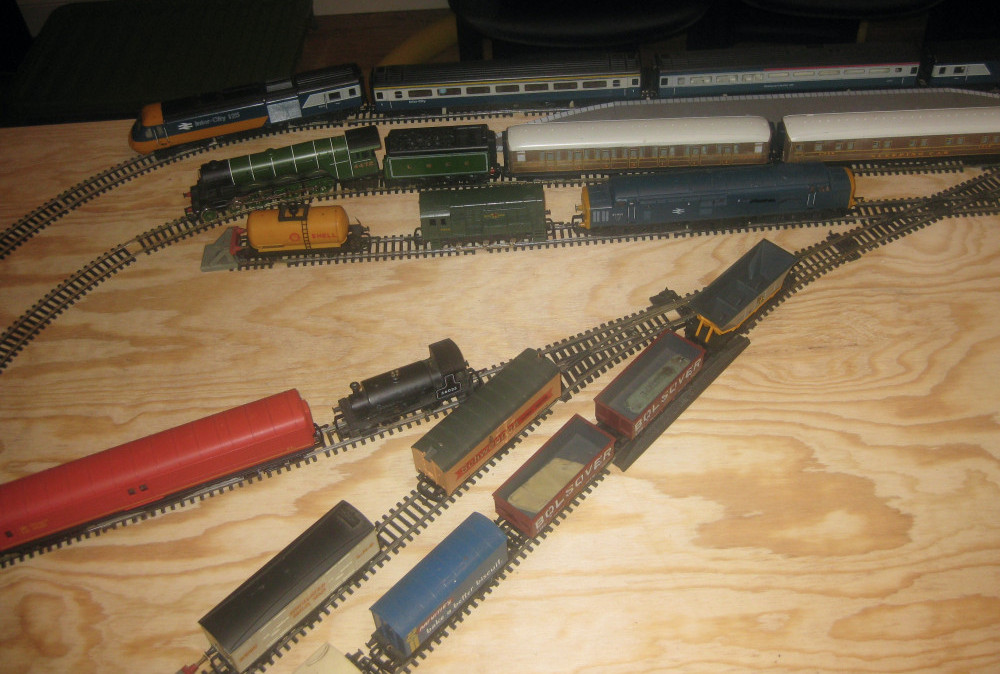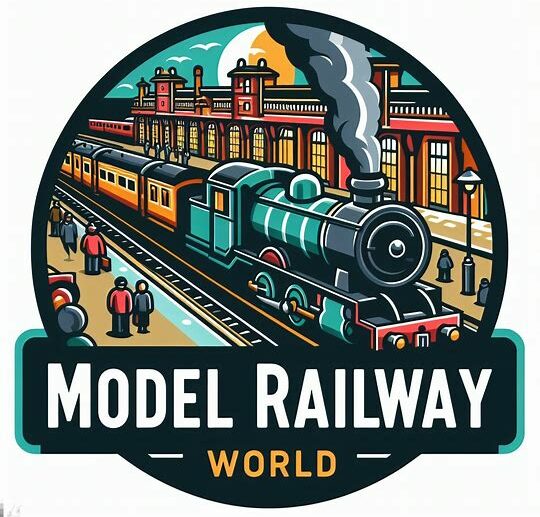When building a model railway, whatever the gauge, one of the most important steps is to choose the right surface to build your layout on. There are many types of wood you can lay your track on, and choosing the correct type of surface to lay your track on is critical to the successful running of your train set as a whole. So what is the best baseboard for a model railway ? – read on to find out more!

* This is a photo of a simple Hornby layout I built for my son on a 6×3 baseboard as shown in my ‘About Me‘ page
Why do we need a baseboard ?
For every type of model railway, the baseboard is the main foundation. And although it is mostly hidden from view when a layout is completed, the importance of a good baseboard should not be ignored. This is because if at some point the baseboard is found to be defective in some way then you may have to dismantle the whole layout and rebuild it again !
You may actually wonder why we need a baseboard at all. Once upon a time train sets were mainly O gauge, which is roughly twice the size of OO gauge. O gauge track is quite wide, therefore it could just be laid on the floor or carpet, without the need for a baseboard. The track is also robust and not easily damaged, unlike some smaller gauge track. The advantage of not needing a baseboard in this example was that it is fun to lay the track directly on the floor, laying it around and under chairs, tables – even around the Christmas tree if it was that time of year !
Whilst the larger O gauge is indeed fun and has its advantages, the most popular gauges are OO, HO and the even smaller N gauge. You can find out what the differences are between the gauges in my other post here.
When laying smaller scale track such as OO and N gauge, this smaller track can be very brittle and prone to damage if care is not taken when laying, so for this reason the floor is unsuitable. So we know a baseboard is essential, and track is usually fixed to the baseboard using small track pins.
Choosing the right baseboard
There are a variety of factors that you must consider that may influence the size and type of the baseboard you choose for your layout. The shape and the size of the layout, where it will be located and / or stored, if it will be a permanent or portable baseboard. You must also factor in whether you plan to add any modifications to it in the future, such as possibly extending the layout or adding inclines and bridges etc.
If you are new to model railways, then I would recommend a standard 6ft by 4ft layout for which there are many track plans available either online or from layout books from Hornby for example. Alot of fun can be had from a relatively small layout such as a 6 by 4 size, thus maintenance or adding additional features will not be time-consuming nor require much effort.
Indeed, once you grasp the basic skills of building a small layout, you can then move onto more ambitious projects such as large room layouts such as a loft layout, or a shed layout for example. I would advise that anything bigger than 6ft by 4ft should be on a permanent baseboard or in separate sections.
For larger layouts, even those layouts that you don’t intent to move, it is worth considering arranging the construction in such a way so that the baseboard can be taken apart easily into smaller parts, without causing damage. This is also beneficial because at some point you may want to change the shape or design of the layout too, thus removing, adding & arranging sections will make this easier in the long run. And also if you move house, you can take your layout with you. The ideal size and dimensions for a portable layout is typically 4ft x 2ft.
Type Of Wood To Use
Commonly, there are two types of wood that most people use to build their layouts on:
Plywood
Available from most DIY stores, who can often cut it to size. Plywood is very strong, durable and flexible. It also cheap, but make sure that you use at least a thickness between 9mm & 12mm. This will ensure that it is strong enough to support your layout, and also easier to pin the track to board and fix the wiring through it. This is my no1 choice.
AVOID MDF wood. Whilst this is tempting, it can be difficult to drive track pins through this type of wood, and is also susceptible to humidity and moisture !
Chipboard
Another common wood to that people use but not many people realise that chipboard is even more prone to moisture and humidity, and is also difficult to work with. It’s cheap too and available from most DIY stores but best avoided.
Baseboard height
For model railway layouts, there is no real correct height, but in order for the railway to be enjoyed properly and also to ensure easy access to the layout, the baseboard should just be at eye level, just a little higher than table height so the easiest way to reach across a layout is when the baseboard is at waist height. It is therefore easier to operate the layout when you have an overall or ‘birds eye’ view of the entire layout. The width of the layout is also important, and the width will essentially determine how high the layout should stand.
Conclusion
Choosing the right baseboard is critical to the overall operation and management of your layout, and Plywood should be used over other types of wood if at all possible. The size and type of baseboard should always be determined by the dimensions of the room or area you choose to build your layout. Remember that the eventual baseboard should not restrict your movement around your layout. The ultimate success of your layout revolves entirely around the quality, size & dimensions of your baseboard and I think the information I have provided will help you to succeed.

Very well done Tim. Very informative and helpful. You described pretty much everything my dad did for me when I was young. He used 1/2″ thick plywood and covered it with green felt. I only one teeny tiny error. You left out a word in the Baseboard Height paragraph, second sentence. Shouldn’t it read “the baseboard ‘should’ just be at eye level? Other than that, I loved it. Keep that train amovin’!!
I have fond memories of my brother’s train set when we were kids. Now that I’m retired, I’m thinking it may be time to set one up for the grandkids!! I appreciate the information you’ve posted here but I do have one question. What sort of board are we using for the baseboard? Should I be using plywood? If so, what thickness is best? I look forward to your answers!
Hello Cynthia,
Thanks for your comments. I would say that using either Plywood or Chipboard is recommended.
When I was living in England, my family used to visit model train exhibitions. That was some years ago. I love watching them go round, under tunnels, and over hills; they are awesome. Thank you for bringing back fond memories.
Brilliant post! You have brought back fond memories for me.
You have explained the topic well, easy to read and is understandable.
You have covered in detail the baseboard, and you have explained how to choose the best baseboard.
I remember model trains used to be on a table, and my brother would use planks of wood to make the track longer. I was wondering, Have you done a post on when model trains were first invented?
Hi Yvonne,
Thanks for your comments. Everyone has some memories of model railways, it is such an exciting hobby and I am pleased my post helped to bring some memories back for you. I have not written a post yet on the history of model trains – that is a great idea and I intend to look into that 🙂
Thanks again,
Tim